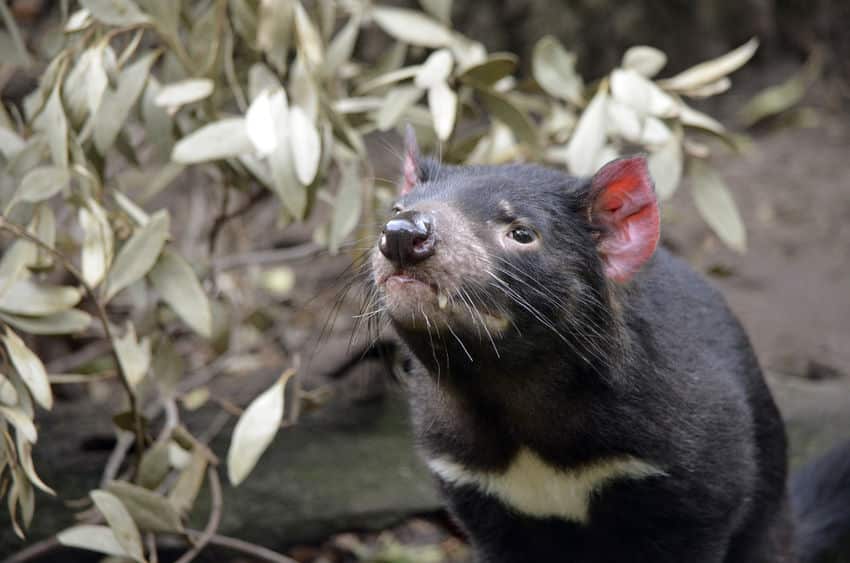By John Salak –
Tasmanian Devils, those cute yet ferocious carnivorous marsupials, may be able to teach virtually everyone a lesson on hanging tough. Found until recently exclusively on the state island of Tasmania, these dog-sized critters were first pushed out of Australia by dingoes thousands of years ago; were almost hunted into extinction in the early 19th Century by Tasmanian settlers and then got whacked by the devil facial tumor disease (DFTD) that surfaced in the late 20th Century. The facial tumor attack alone wiped out between 20-80 percent of the native population.
Now these devils are making something of a comeback and in the process they may be shedding new light on how humans can better tackle battles with cancer.
The facial tumor disease these animals endure is particularly dangerous because unlike most other cancers it is transferrable—much like an infectious disease. It is also extremely dangerous. DFTD is usually spread among devils when they bite each other during mating season. The cancer can kill an animal within six months.
University of Idaho researchers, partnering with other scientist from the U.S. and Australia, have found that the genetic diversity of Tasmanian Devils is evolving in wild populations. Along with natural selection of different types of genes, this is giving the species better chance of offsetting the devastating impact of the cancer. The research may also help conservation efforts that support the survival of the devils.
“Our work suggests that maintaining genetic diversity across a wide set of functionally important genes is critical to make sure Tasmanian Devils are able to adapt to transmissible cancers and other threats to their survival,” said Paul Hohenlohe, an associate professor at the Idaho university and lead author of the study.
This genetic evolution isn’t just good news for these devils, research out of Washington State University and the Fred Hutchinson Cancer Research Center in Seattle reports the process may offer hope for new treatment for human cancers.
This team came to its conclusions after studying the genomes of cases of DFTD that regressed spontaneously, in effect began disappearing on its own. The researchers were surprised to find the mutation contributing to tumor regression did not change the gene’s function but rather ignited a gene that slows the tumor’s growth.
“This gene is implicated in human prostate and colon cancers,” noted Andrew Storfer, a professor at WSU. “While the findings hold the most immediate promise to help save the world’s few remaining Tasmanian devils, these results could also someday translate to human health.”
The real payback for individuals suffering from these cancers would come if traditional therapies focusing on removing every trace of a tumor, often through toxic or debilitating treatments, could be replaced by more benign approaches.
“If there were ways that tumors could be tricked into regressing without having to administer cytotoxic drugs or deforming surgeries, it would be a major advance,” explained David Hockenbery, a cancer biologist at Fred Hutchinson Center who contributed to the study.
These devils offer another benefit in that they may just provide a reasonably easy way to study and advance this approach. Though tough with each other, Tasmanian Devils take well to mild handling from people, making it easy to study these animals and release them back into the wild unharmed.
“Although this disease is largely fatal, we’re seeing tumors just disappear from an increasing number of individual animals,” Storfer said. “We hope to learn something that could be applied to understanding and possibly treating a number of human cancers in the future.”
A seeming regression of the disease coupled with growing support from various academic institutions looking into their wellbeing isn’t the only good news for these animals. After an absence of nearly 3,000 years, they are making a comeback in Australia.
Aussie Ark, an Australian nonprofit dedicated rewilding the country, reported in late May that seven Tasmanian Devils were born in the wild in Australia for the first time in more than three millennium. The organization sees these births as a first tentative step in expanding the range of this endangered animal.
“We’ve been able to historically, albeit in its infancy, return the devils to the mainland,” reported Aussie Ark president Tim Faulkner. “And today is another milestone entirely,” he added, citing the wild births.
The newborn devils came after the group released 26 animals into a wild sanctuary on the mainland. “The wilds of mainland Australia are experiencing a special kind of baby boom—one that hasn’t happened here in more than 3,000 years,” Faulker noted.













